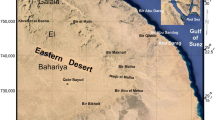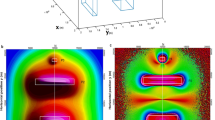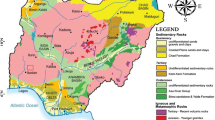Abstract
In this study, different interpretation techniques have been applied to the airborne magnetic data to detect the subsurface basaltic edges in Qaret Had El Bahr area, Northeastern Bahariya Oasis, Egypt. These techniques are as follows: the power spectrum, Source Parameter Imaging (SPI), tilt derivative or tilt angle, Euler deconvolution, and forward modeling. The depth to the basement calculated from the different techniques is mostly matched. Also, the lineaments have been analyzed by extracting these lineaments from the geological map, Reduction to the Pole (RTP) magnetic map, and regional and residual magnetic map. The rose diagrams of these lineaments have been established to define the main trends in the study area as well as the trend of the basalt, which is the main target in this study.
















Similar content being viewed by others
References
Aboud E, Salem A, Mekkawi M (2011) Curie depth map for Sinai Peninsula, Egypt deduced from the analysis of magnetic data. Tectonophysics 506:46–54
Aero-Service (1984) Final operational report of airborne magnetic/radiation survey in the Eastern Desert, Egypt. For the Egyptian General Petroleum Corporation (EGPC) and the Egyptian Geological Survey and Mining Authority (EGSMA), Aero-Service Division, Houston, Texas, USA, Six Volumes
Al-Badani M.A, Al-Wathaf Y.M (2017) Using the aeromagnetic data for mapping the basement depth and contact locations, at southern part of Tihamah region, western Yemen. Egypt J Pet 27(4):485–495
Al-Garni MA (2010) Magnetic survey for delineating subsurface structures and estimating magnetic sources depth, Wadi Fatima, KSA. J King Saud Univ Sci 22:87–96
Beadnell HJL (1905) The topography and geology of the Fayum Province of Egypt. Survey Department of Egypt, Cairo 101
Conoco (1986) Geological map of Egypt, Scale (1:500,000), NH 35 SE-Bahariya sheet
Deng Y, Chen Y, Wang P, Essa KS, Xub T, Liang X, Badal J (2016) Magmatic underplating beneath the Emeishan large igneous province (South China) revealed by the COMGRA-ELIP experiment. Tectonophysics 672–673:16–23
El Sirafie A.M (1986) Application of aeromagnetic, aeroradiometric and gravimetric survey data in the interpretation of the geology of Cairo-Bahariya area, North Western Desert, Egypt. Ph.D. thesis, Ain Shams University 154p
Elkhodary ST, Youssef MAS (2013) Integrated potential field study on the subsurface structural characterization of the area North Bahariya Oasis, Western Desert, Egypt. Arab J Geosci 6:3185–3200
Eppelbaum LV (2015) Quantitative interpretation of magnetic anomalies from bodies approximated by thick bed models in complex environments. Environ Earth Sci 74(7):5971–5988
Essa KS, Elhussein M (2016) A new approach for the interpretation of magnetic data by a 2-D dipping dike. J Appl Geophys 136:431–443
Fairhead J.D, Williams S.E, Flanagan G (2004) Testing magnetic local wavenumber depth estimation methods using a complex 3D test model. 74th Annual International Meeting, SEG Expand Abstr. 742e745
Gabtni H, Hajjia O, Jalloulibc C (2016) Integrated application of gravity and seismic methods for determining the dip angle of a fault plane: case of Mahjouba fault (Central Tunisian Atlas Province, North Africa). J Afr Earth Sci 119:160–170
Kusky TM, Hassaan MM, Gabr S (2011) Structural and tectonic evolution of El-Faiyum Depression, North Western Desert, Egypt based on analysis of Landsat ETM+, and SRTM data. J Earth Sci 22(1):75–100
Li X (2008) Magnetic reduction-to-the-pole at low latitudes: observations and considerations. Lead Edge 27(8). https://doi.org/10.1190/1.2967550
MacLeod IN, Jones K, Dai TF (1993) 3-D analytic signal in the interpretation of total magnetic field Data at low magnetic latitudes. Explor Geophys 24(3–4):679–687
Maineult A (2016) Estimation of the electrical potential distribution along metallic casing from surface self-potential profile. J Appl Geophys 129:66–78
Mehanee S (2014) Accurate and efficient regularized inversion approach for the interpretation of isolated gravity anomalies. Pure Appl Geophys 171(8):1897–1937
Mehanee S, Zhdanov M (2002) Two-dimensional magnetotelluric inversion of blocky geoelectrical structures. J Geophys Res Solid Earth 107(B4):EPM 2–1–EPM: 2–11
Miller HG, Singh V (1994) Potential field tilt—a new concept for location of potential field sources. J Appl Geophys 32:213–217
Oasis Montaj Program v7.1. (2009) Geosoft mapping and processing system, version 7.1
Ogunmola JK, Ayolabi EA, Olobaniyi SB (2016) Structural-depth analysis of the Yola Arm of the Upper Benue Trough of Nigeria using high resolution aeromagnetic data. J Afr Earth Sci 124:32–43
Oruç B, Selim HH (2011) Interpretation of magnetic data in the Sinop area of Mid Black Sea, Turkey, using tilt derivative, Euler deconvolution, and discrete wavelet transform. J Appl Geophys 74(4):194–204
Paoletti V, Ialongo S, Florio G, Fedi M, Cella F (2013) Self-constrained inversion of potential fields. Geophys J Int 195:854–869
Pei J, Li H, Wang H, Si J, Sun Z, Zhou Z (2014) Magnetic properties of the Wenchuan earthquake fault scientific drilling project Hole-1 (WFSD-1), Sichuan Province, China. Earth Planet. Space 66(23):1–12
Rama Rao C, Kishore RK, Pradeep Kumar V, Butchi Babu B (2011) Delineation of intra crustal horizon in Eastern Dharwar Craton – an aeromagnetic evidence. J Asian Earth Sci 40(2):534–541
Reddi AGB, Mathew MP, Baldau S, Naidu PS (1988) Aeromagnetic evidence of crustal structure in the granulite terrane of Tamil Nadu–Kerala. J Geol Soc India 32:368–381
Reford MS, Sumner JS (1964) Aeromagnetics. Geophysics 29(4):482–516
Reid AB, Alsop JM, Grander H, Millet AJ, Somerton IW (1990) Magnetic interpretation in three dimensions using Euler deconvolution. Geophysics 55(1):80–91
Roest WR, Pilkington M (1993) Identifying remanent magnetization effects in magnetic data. Geophysics 58:653–659
Roset WR, Verhoef J, Pilkington M (1992) Magnetic interpretation using 3-D analytic signal. Geophysics 57:116–125
Saad MH, El-Khadragy AA, Shabaan MM, Azab A (2010) An integrated study of gravity and magnetic data on South Sitra area, Western Desert, Egypt. J Appl Sci Res 6(6):616–636
Said R (1962) The geology of Egypt. Elsevier, Amsterdam, p 377
Salawu N.B, Olatunji S, Orosun M.M, Abdulraheem T.Y (2019a) Geophysical inversion of geologic structures of Oyo Metropolis, Southwestern Nigeria from airborne magnetic data Geomechanics and Geophysics for Geo-Energy and Geo-Resources, https://doi.org/10.1007/s40948-019-00110-7
Salawu NB, Olatunji S, Adebiyi LS, Olasunkanmi NK, Dada SS (2019b) Edge detection and magnetic basement depth of Danko area, northwestern Nigeria, from low-latitude aeromagnetic anomaly data. SN Appl Sci 1:1056. https://doi.org/10.1007/s42452-019-1090-3
Salem A, Williams S, Fairhead JD, Ravat D, Smith R (2007) Tilt depth method, a simple depth estimation method using first-order magnetic derivatives. Lead Edge 26(12):1502–1505
Selim EI (2016) The integration of gravity, magnetic and seismic data in delineating the sedimentary basins of northern Sinai and deducing their structural controls. J Asian Earth Sci 115:345–367
Selim E, Aboud E (2012) Determination of sedimentary cover and structural trends in the Central Sinai area using gravity and magnetic data analysis. J Asian Earth Sci 43:193–206
Sheriff SD (2010) Matched filter separation of magnetic anomalies caused by scattered surface debris at archaeological sites. Near Surface Geophysics 8:145–150
Spector A, Grant FS (1970) Statistical models for interpreting aeromagnetic data. Geophysics 35(2):293–302
Talwani M, Heirtzler J.R (1964) Computation of magnetic anomalies caused by two-dimensional bodies of two-arbitrary shape. In: Parks, G.A. (Ed.), Computers in the mineral industries, part 1. In: Stanford University publications, geological sciences 9: 464–480
Thompson DT (1982) EULDPH—a technique for making computer-assisted depth estimates from magnetic data. Geophysics 47:31–37
Thurston JB, Smith RS (1997) Automatic conversion of magnetic data to depth, dip, and susceptibility contrast using the SPI (TM) method. Geophysics 62(3):807–813
Verduzco B, Fairhead JD, Green CM, Mackenzie C (2004) New insights into magnetic derivatives for structural mapping. Lead Edge 23(2):116–119
Vondra CF (1974) Upper Eocene transitional and near-shore marine Qasr El Sagha Formation, Fayum Depression, Egypt. Ann Geol Surv Egypt 4:74–94
Zhdanov MS, Ellis R, Mukherjee S (2004) Three-dimensional regularized focusing inversion of gravity gradient tensor component data. Geophysics 69(4):925–937
Acknowledgments
The authors would like to thank Prof. Louis N.Y. Wong, Editor-in-Chief, and the four capable reviewers for their keen interest, valuable comments on the manuscript, and improvements to this work.
Author information
Authors and Affiliations
Contributions
Mahmoud Elhussein and Mohamed Shokry wrote the main manuscript text. Mohamed Shokry prepared Figs. 1, 2a, b, 3, 8, and 13; Mahmoud Elhussein prepared Figs. 4, 5a, b, 6, 7, 9, 10, 11, and 12; Mohamed Shokry and Mahmoud Elhussein made together Figs. 14 and 15. Mohamed Shokry and Mahmoud Elhussein wrote the results, discussion, and conclusions.
Corresponding author
Ethics declarations
Competing interests
The authors declare that they have no competing interests.
Rights and permissions
About this article
Cite this article
Elhussein, M., Shokry, M. Use of the airborne magnetic data for edge basalt detection in Qaret Had El Bahr area, Northeastern Bahariya Oasis, Egypt. Bull Eng Geol Environ 79, 4483–4499 (2020). https://doi.org/10.1007/s10064-020-01831-w
Received:
Accepted:
Published:
Issue Date:
DOI: https://doi.org/10.1007/s10064-020-01831-w




